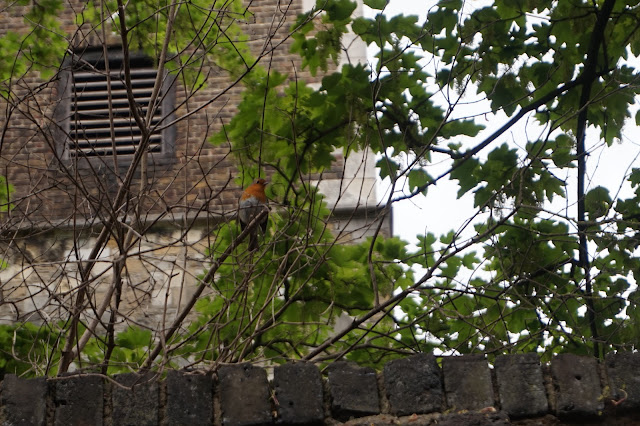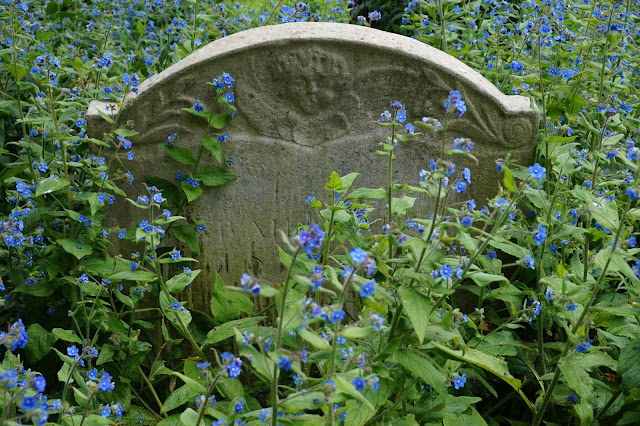Today I am starting with the end of my day and working forward. The picture above is of the "Long Water" from the Italian Gardens in Hyde Park. My focus today was mathematician John Dee, so I started out by taking a train from Waterloo Station and stopping off at Mortlake (his home) and Richmond (the home of Queen Elizabeth I, whom he advised). I'll end the post with the "mathy stuff" so that those who are so inclined may skip that part easily. Obviously, everyone wants to get the above photo, and the ladies below were so lovely that I snapped a photo of them as well when I was waiting to get my clear shot of the "Long Water."
I am actually here, despite not showing up in many photos. Here I am among the spring blooms of Hyde Park (but then again, I suppose this could be anywhere, but I am really here!). This picture is just west of the Italian Gardens, and it seems that spring has sprung!

I did some evening reading after dinner in the Italian Gardens of Hyde Park. In light of the recent pandemic and having had to flee London two years ago and all the "vax battles" that have been going on in the US, it seems somehow ironic that I am sitting in the shadow of a statue to Edward Jenner, who pioneered the idea of vaccination.
The earlier part of the day was filled with travel.
I'm really getting to know the train stations - a trip home to Paddington (above) after a trip out from Waterloo (below).I began in Mortlake, former home of John Dee, which is what I will end this post with. After Mortlake was a visit to Richmond where Queen Elizabeth I had a palace (as did her father and his father before him). Actually, some sort of royal residence has stood here since Edward I all the way back in 1125 (then Cromwell came in with his destructive forces, but that's another post for someone else's blog). Below is nearly all that remains of the Tudor Palace: one gate house:
Richmond Green, near the gate, is where jousting tournaments were held in medieval times.
My reason for visiting both Richmond and Mortlake is to look further into the life of John Dee, who was Elizabeth's tutor and advisor and astrologer. Five times that we know of, Queen Elizabeth actually visited Dee at his home, something I find quite surprising. I can't imagine the queen visited too many of her subjects at their homes -- some of the nobles in their vast and magnificent manor houses, yes, but a commoner like Dee? Not only did she stop by Dee's place, but it was typically a surprise when she showed up. The first of these visits was on March 16, 1575, and she arrived only to find that Dee's wife had died and was to be buried that day! He invited her in, but she declined and spoke with him by the church wall. She never did go inside his modest home, but she did stop by to speak with him at least four more times. They each had a "home" bordering the Thames -- well, she had multiple "homes" bordering on the Thames, but this one was particularly close to Mortlake -- and she could get to his place on her royal barge; she also arrived on horseback at least one of these times.
On part of what used to be his property is a row of flats called the John Dee House. This is across the street from the river, and all of this property belonged to Dee. He had a humble home that he added wings onto in order to hold his ever-growing library, which became the largest library in Britain.
Lots of pictures of the wall follow. Feel free to scroll past quickly to get to pictures of the church and church yard. I'm just taking a really close look for my own sake.
I was unable to get inside the church, but I spent a lot of time in the atmospheric church yard. Dee is buried inside, though it is not known exactly where. The church is quite an eclectic combination of styles, so here too it's a bit hard to know what goes back to Dee's time. The red brick part of the tower below seems to me to be Tudor.
I took some time to sit on this lovely bench and do some journaling.
Well, I guess this didn't get all that "mathy," did it? I'm going to close with a few pretty random photos just because. The first is something that caught my attention just to the side of the church entrance. It looks like someone made a little diorama in honor of the recent Easter celebration. Anyone know what meaning a shell might have here?
Oh - wait, wait wait! For those of you reading this with a desire to visit Mortlake or who are studying Dee and want to get an idea of how all of the above fits together, I have a LONG (5 min.) video where I walk between the three locations - Dee House, St. Mary's Church, and the riverfront area. It's rough and long, but if context is what you're after, here it is!





































No comments:
Post a Comment